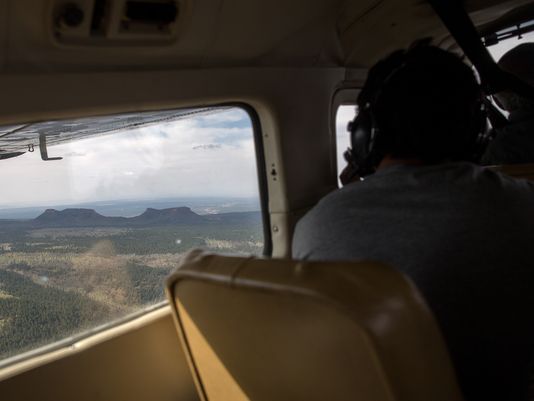Sources: The Spectrum, Farmington Daily Times, and Deming Headlight
After signing an executive order calling for a review of more than two dozen national monuments, President Donald Trump handed the pen to U.S. Sen. Orrin Hatch, crediting the Utah Republican for being a driving force behind the order.
“Believe me, he’s tough,” Trump said, nodding to Hatch during the April 26 signing ceremony. “He would call me and say, ‘You gotta do this.’ Is that right, Orrin?”
Two weeks later, Hatch and the rest of Utah’s all-Republican congressional delegation were meeting with newly-appointed Interior Secretary Ryan Zinke ahead of his on-site visit to the Bears Ears and Grand Staircase-Escalante national monuments, Utah’s two largest and the two that Hatch calls examples of Washington-ordered “land grabs” that lock out local communities.
The 83-year-old was already a 20-year veteran of the Senate when then-President Bill Clinton signed the Grand Staircase into monument status in 1996, and when he saw Bears Ears leaning the same direction two decades later he said the similarities were obvious.
“Nearly 20 years ago, the Clinton administration blindsided Utah with a massive 1.9-million-acre monument designation in Southern Utah,” Hatch said, saying that in both cases a monument designation would go against the will of Utah’s elected representatives and local residents.
The debate over those two monuments has made Utah ground zero in what is likely to become a wide-ranging political battle over monument designations, one that most observers expect to end up being fought in the courtroom.
On one side is the contention that Bears Ears, like other western monuments, is among the places most in need of protection, an undulating collection of mountainous terrain rich in cultural significance to native tribes, thousands of archaeological sites, paleontological resources, scenic landscapes and some of the nation’s darkest night skies.
A large coalition of tribal leaders, environmentalist groups, archaeologists and others fought for the monument designation.
The monument proposal had the support of six of the seven Navajo chapters in the state, along with representatives from some two dozen other tribes and the National Congress of American Indians, as well as organizations like the Friends of Cedar Mesa and the Utah Diné Bikéyah, a conservation organization led by Native Americans.
“National monuments are designated so they may be preserved for all the people of the United States,” said Madison Hayes, content manager for the advocacy group Alliance for a Better Utah. “These are national treasures. Once they are lost and sold off for development and extraction, there is no way to return these beautiful lands to their original state.”
But Bears Ears, like the nearby Grand Staircase, is also rich with natural resources that area leaders contend could help prop up poor economies.
When Clinton signed the Grand Staircase into law, it closed ideas of mining coal out of potentially rich beds beneath the Kaiparowits Plateau, where the U.S. Geological Survey had suggested there were some 30 billion tons of minable coal.
Both monuments house what researchers suggest could be rich deposits of gas, oil, uranium and other resources.
Utah officials have long argued that environmental protections could be maintained while allowing for some resource extraction, and most have argued that both monuments ignored the wishes of local leadership.
“Utahns deserve a collaborative land management process that ensures local residents have a seat at the table,” said U.S. Rep. Chris Stewart, whose district includes the Grand Staircase monument.
Legal experts suggest Trump would have difficulty unilaterally rescinding a national monument designated by a previous president, since that ability is not spelled out in the Antiquities Act.
But there are arguments that he could amend or shrink the borders of monuments.
Congress has acted in the past to remove monument status and to make changes to existing monuments, and Utah’s lawmakers have been among those proposing legislative changes to the 1906 law.
Last year, Hatch and Sen. Mike Lee proposed one measure that would have allowed monument designations to expire if states didn’t sign off on them, and then a second bill that proposed exempting Utah from any new monuments. Neither made it to a vote.
Similarly, the Public Lands Initiative, legislation developed by Utah Reps. Rob Bishop and Jason Chaffetz as an alternative to the Bears Ears monument designation, never saw a vote.
But Trump’s win on Election Day has raised the hopes of state officials that a Republican administration might take a different look at the monuments.
Utah’s back-and-forth with federal agencies over control of federally-controlled lands within its borders goes back decades, reaching a fevered pitch in recent years as state lawmakers propose suing over control of about 31 million acres.
County commissioners, along with county and municipal leadership across the region, Utah Gov. Gary Herbert and other state leaders have pushed for changes to the monument designation.
The Legislature passed a resolution this year demanding the federal government revisit the issue.
Follow David DeMille on Twitter, @SpectrumDeMille, and on Facebook at www.facebook.com/SpectrumDeMille. Call him at 435-674-6261.
Read Spectrum article here, Farmington Daily Times article here, or Deming Headlight article here.

